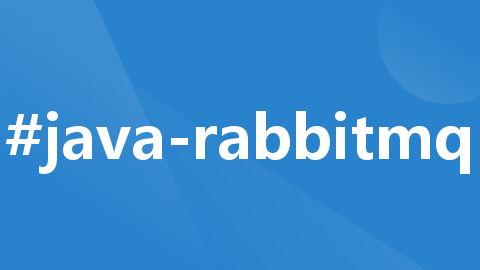
RabbitTemplate的创建与配置
RabbitTemplate是我们在与SpringAMQP整合的时候进行发送消息的关键类该类提供了丰富的发送消息的方法,包括可靠性消息投递、回调监听消息接口ConfirmCallback、返回值确认接口ReturnCallback等等同样我们需要注入到Spring容器中,然后直接使用。在与spring整合时需要实例化,但是在与Springboot整合时,只需要添加配置文件即可首先将其注入到bean
创建与配置
RabbitTemplate是我们在与SpringAMQP整合的时候进行发送消息的关键类
该类提供了丰富的发送消息的方法,包括可靠性消息投递、回调监听消息接口ConfirmCallback、返回值确认接口
ReturnCallback等等同样我们需要注入到Spring容器中,然后直接使用。
在与spring整合时需要实例化,但是在与Springboot整合时,只需要添加配置文件即可
首先将其注入到bean里面:
如果自己不注入
那么RabbitAutoConfiguration中也会最RabbitTemplate进行自动装配。
@Bean
@ConditionalOnSingleCandidate(ConnectionFactory.class)
@ConditionalOnMissingBean({RabbitOperations.class})
public RabbitTemplate rabbitTemplate(RabbitTemplateConfigurer configurer, ConnectionFactory connectionFactory) {
RabbitTemplate template = new RabbitTemplate();
configurer.configure(template, connectionFactory);
return template;
}
connectionFactory是用于创建与rabbitMq服务器之间通信的链接工场类。
configurer对rabbitTemplate进行配置
配置方法
public void configure(RabbitTemplate template, ConnectionFactory connectionFactory) {
PropertyMapper map = PropertyMapper.get();
template.setConnectionFactory(connectionFactory);
if (this.messageConverter != null) {
template.setMessageConverter(this.messageConverter);
}
template.setMandatory(this.determineMandatoryFlag());
Template templateProperties = this.rabbitProperties.getTemplate();
if (templateProperties.getRetry().isEnabled()) {
template.setRetryTemplate((new RetryTemplateFactory(this.retryTemplateCustomizers)).createRetryTemplate(templateProperties.getRetry(), Target.SENDER));
}
templateProperties.getClass();
map.from(templateProperties::getReceiveTimeout).whenNonNull().as(Duration::toMillis).to(template::setReceiveTimeout);
templateProperties.getClass();
map.from(templateProperties::getReplyTimeout).whenNonNull().as(Duration::toMillis).to(template::setReplyTimeout);
templateProperties.getClass();
map.from(templateProperties::getExchange).to(template::setExchange);
templateProperties.getClass();
map.from(templateProperties::getRoutingKey).to(template::setRoutingKey);
templateProperties.getClass();
map.from(templateProperties::getDefaultReceiveQueue).whenNonNull().to(template::setDefaultReceiveQueue);
}
从配置方法中可以看出来,用户可以对rabbitTemplate做的一些自定义操作。
mandatory
一. Confirm消息确认机制和Return机制
Confirm消息确认机制: 生产者向MQ投递完消息后,要求MQ返回一个应答,生产者异步接收该应答,用来确定该消息是否正常的发送到了Broker, 从而保障消息的可靠性投递
Return消息返回机制:该机制用于处理一些不可路由的消息。如果生产在发送消息时,发现当前的exchange不存在或者指定的路由key找不到时,生产者可以开启该模式来监听这种不可达的消息,以进行后续。(如果不开启的话,broker会自动删除该消息)
这里要注意的是,只要消息到达了MQ就换返回Confirm消息,接下来MQ再去判断能不能找到路由方式,找不到再返回Return消息
Confirm消息确认机制的实现
confirm-type有none、correlated、simple这三种类型
none:表示禁用发布确认模式,默认值,使用此模式之后,不管消息有没有发送到Broker都不会触发 ConfirmCallback回调。
correlated:表示消息成功到达Broker后触发ConfirmCalllBack回调
simple:simple模式下如果消息成功到达Broker后一样会触发
- 首先在配置文件中设置
spring:
rabbitmq:
publisher-confirm-type: correlated
开启消息确认模式
- 实现ConfirmCallback接口
RabbitTemplate.ConfirmCallback confirmCallback = new RabbitTemplate.ConfirmCallback() {
@Override
public void confirm(CorrelationData correlationData, boolean ack, String cause) {
if (ack){
log.info(correlationData.toString() + "发送成功");
}else {
log.error(correlationData.toString() + "发送失败, 原因: " + cause);
}
}
};
其中重写的方法包含三个参数:
correlationData:发送消息时设置的correlationData。由于confirm消息是异步监听的,因此需要在发送消息时传递一个correlationData,从而在返回confirm消息时判断其属于哪个消息,所以correlationData通常设置为消息的唯一ID;
ack:broker返回的应答,如果broker成功接收消息,则返回true代表接收成功,如果因为各种原因没有成功接收(如消息队列满了),则返回false
这里要注意,由于各种原因(如网络波动),生产端可能并没有收到confirm消息,因此不能将后续的补偿处理仅仅寄希望于在else内完成,else内做的补偿仅仅是在生产端收到confirm消息后nack的情况
- cause: 如果没有被成功接收,则返回原因
- 为rabbitTemplate添加刚刚的Confirm监听器
rabbitTemplate.setConfirmCallback(confirmCallback());
Return消息返回机制的实现
- Return消息返回机制的实现与上面的Confirm消息确认机制的实现类似
spring:
rabbitmq:
publisher-returns: true
template:
mandatory: true
注意,mandatory一定要设置为true,否则找不到路由规则的消息会被broker直接抛弃
- 实现returnCallback接口
RabbitTemplate.ReturnCallback returnCallback = new RabbitTemplate.ReturnCallback() {
@Override
public void returnedMessage(Message message, int replyCode, String replyTest, String exchange, String routingKey) {
log.error("消息{}路由失败,失败原因:{}",message.getMessageProperties().getMessageId(),replyTest);
}
};
MessageConverter
Rabbit原始的序列化方法是把数据转化为字节数组。
我们调用rabbitTemplate的convertAndSend方法时
@Override
public void convertAndSend(String exchange, String routingKey, final Object object,
@Nullable CorrelationData correlationData) throws AmqpException {
send(exchange, routingKey, convertMessageIfNecessary(object), correlationData);
}
rabbitmq会进行序列化操作
protected Message convertMessageIfNecessary(final Object object) {
if (object instanceof Message) {
return (Message) object;
}
return getRequiredMessageConverter().toMessage(object, new MessageProperties());
}
private MessageConverter messageConverter = new SimpleMessageConverter();
如果不指定。那么使用的是SimpleMessageConverter
使用的是转化为二进制字节数组
public final class SerializationUtils {
private SerializationUtils() {
}
public static byte[] serialize(Object object) {
if (object == null) {
return null;
} else {
ByteArrayOutputStream stream = new ByteArrayOutputStream();
try {
(new ObjectOutputStream(stream)).writeObject(object);
} catch (IOException var3) {
throw new IllegalArgumentException("Could not serialize object of type: " + object.getClass(), var3);
}
return stream.toByteArray();
}
}
/**
* Creates a newly allocated byte array. Its size is the current
* size of this output stream and the valid contents of the buffer
* have been copied into it.
*
* @return the current contents of this output stream, as a byte array.
* @see java.io.ByteArrayOutputStream#size()
*/
public synchronized byte toByteArray()[] {
return Arrays.copyOf(buf, count);
}
接受消息的时候需要准换回string,再进一步进行操作
new String(message.getBody()));
public void ListenerQueue01(Message message){
String body = new String(message.getBody()));
System.out.println("body===="+body);
logger.info("[onMessage][线程编号:{} 消息内容:{}]", Thread.currentThread().getId(), message);
}
那么如果我们需要指定序列化方法,只要自定义一个返回json数据类型的MessageConverter就可以了。
代码:
@Configuration
public class MyMsgConverter {
@Bean
public MessageConverter messageConverter(){
return new Jackson2JsonMessageConverter();
}
}
在发送和接受消息的时候,会自动进行序列化操作
可以这么接收消息
@RabbitListener(queues = "QUEUE_DEMO_DIRECT")
public void ListenerQueue01(Message message, Map data){
System.out.println("mess===="+message);
logger.info("[onMessage][线程编号:{} 消息内容:{}]", Thread.currentThread().getId(), message);
}
RetryTemplate
这个等待研究rabbitMq的重试策略的时候再进行说明
receiveTimeout
receive() 操作的超时时间
这个方法是消费者使用的方法
rabbitTemplate的receive方法是用来接收消息的方法
例如配置
spring:
# RabbitMQ 配置项,对应 RabbitProperties 配置类
rabbitmq:
template:
receiveTimeout: 5s
@Test
public void receiveTest() {
Message queue_demo_direct = rabbitTemplate.receive("QUEUE_DEMO_DIRECT");
System.out.println(queue_demo_direct);
}
那么receive方法会阻塞5秒。等待拉消费的新消息,如5秒内都没有新消息过来,那么返回空
ReplyTimeout
sendAndReceive() 操作的超时时间
这个方法是生产者会使用的方法
// 向发布订阅模式里面发送消息
public void sendPublish() {
for (int i = 0; i < 5; i++) {
// rabbitTemplate.convertSendAndReceive("exchange_fanout", "", "测试发布订阅模型:" + i);
rabbitTemplate.convertAndSend("exchange_fanout", "", "测试发布订阅模型:" + i);
}
}
使用 convertAndSend 方法时的结果:输出时没有顺序,不需要等待,直接运行

使用 convertSendAndReceive 方法时的结果:使用此方法,只有确定消费者接收到消息,才会发送下一条信息,每条消息之间会有间隔时间
 总结
总结
convertSendAndReceive(…):可以同步消费者。使用此方法,当确认了所有的消费者都接收成功之后,才触发另一个convertSendAndReceive(…),也就是才会接收下一条消息。RPC调用方式。
convertAndSend(…):使用此方法,交换机会马上把所有的信息都交给所有的消费者,消费者再自行处理,不会因为消费者处理慢而阻塞线程。
示例
rabbitmq:
# host: 192.168.19.128 # RabbitMQ 服务的地址
host: 192.168.159.100 # RabbitMQ 服务的地址
port: 5672 # RabbitMQ 服务的端口
username: ping # RabbitMQ 服务的账号
password: 123456 # RabbitMQ 服务的密码
template:
mandatory: true
receiveTimeout: 5s
replyTimeout: 60s
生产者
@Test
public void DirectExchange() {
Map map = new HashMap<>();
CorrelationData correlationData = new CorrelationData();
map.put("msg","json");
rabbitTemplate.convertSendAndReceive (RabbitmqDirectConfig.EXCHANGE_NAME, "ROUTING_KEY_01", map, correlationData);
System.out.println("发送消息boot mq hello Direct成功");
}
消费者需要使用 receiveAndReply进行恢复,达到rpc调用的效果
@Test
public void receiveTest() {
rabbitTemplate.receiveAndReply("QUEUE_DEMO_DIRECT",
(o)->{
System.out.println(o);
return o;
});
// System.out.println(queue_demo_direct);
}
Exchange,routingKey,defaultReceiveQueue
三个默认值,如果不指定将使用默认配置的交换机和routingkey
defaultReceiveQueue的作用是,receive方法默认拉取消息的队列
@Override
@Nullable
public Message receive() throws AmqpException {
return this.receive(getRequiredQueue());
}
更多推荐
 已为社区贡献4条内容
已为社区贡献4条内容







所有评论(0)